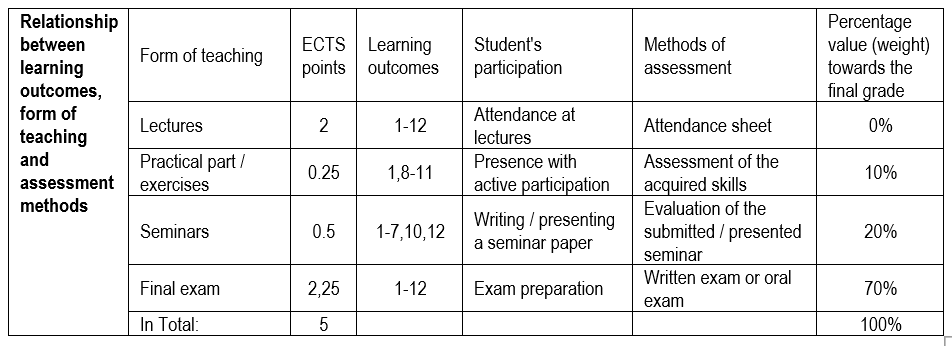Students will learn about fundamental properties of micro-organisms that cause the most common infections in humans and basics of immunology. The seminars serve to expand knowledge from individual fields that are especially important for the work in dental medicine. In the practical classes students will learn about basic microbiological techniques and methods as well as the importance and duration of the most common microbiological examinations.
Structure of the bacterial cell. Metabolism of bacteria, growth and reproduction. Bacterial genetics. Classification and division of bacteria. Normal bacterial flora. Pathogenesis of bacterial infections. Diagnostics of bacterial infections.
Structure of the bacterial cell. Metabolism of bacteria, growth and reproduction. Bacterial genetics. Classification and division of bacteria. Normal bacterial flora. Pathogenesis of bacterial infections. Diagnostics of bacterial infections.
Sterilisation and disinfection with emphasis on specific aspects in dental medicine. Mechanisms of antibiotic and chemotherapy effects. Mechanisms of bacterial resistance to antibiotics. Problem of bacterial resistance spreading.
Significance of pathogenic fungi. Fungi that cause infections of skin and subcutaneous tissue. Opportunistic fungi. Fungi that cause system infections.
Basic properties of viruses. Reproduction of viruses. Viral genetics and sources of viruses. Indirect and direct evidence of viruses. Pathogenesis of viral infections. Viral oncogenesis. Natural antiviral resistance and immune antiviral response. Prions.
Leading causes of infection of the respiratory tract and basics of their laboratory diagnostics. Leading causes of bacteriaemia and sepsis and basics of their laboratory diagnostics. Leading causes of CNS infection and basics of their laboratory diagnostics. Leading causes of infection of the digestive system and basics of their laboratory diagnostics. Leading causes of infections of the kidneys and basics of their laboratory diagnostics. Leading causes of sexually transmitted infections and basics of their laboratory diagnostics. Leading causes of infections of skin, subcutaneous tissue, muscles, joints and bones as well as basics of their laboratory diagnostics. Leading causes of zoonosis and basics of their laboratory diagnostics. Leading causes in immunocompromised patients and basics of their laboratory diagnostics.
Natural resistance. Immune system. Antigens. Antibodies. Hypersensitivity. Autoimmunity. T-cell receptor and MHC molecules. Lymphocyte activation, tolerance. Controlling immune response. Immune response with microbial infections. Infections due to decreased resistance. Immunosuppression. Vaccination and immunisation schedule.
Immune response and inflammation of oral mucosa. Normal oral flora. Micro-organisms in periodontal tissue. Microbiology and immunology of periodontal diseases. Biofilm and caries. Causes of infections of pulp and periapical tissue. Causes of acute odontogenic inflammations. Causes of peri-implantitis. Causes of osteomyelitis of odontogenic origin. Disposal of micro-organisms from instruments (apparatus) and the surrounding. Transmission routes of micro-organisms in dental office. Preventing infections during work in mouth cavity. Vaccination of workers in dental medicine. Infections of mouth cavity due to decreased resistance.
Required course materials:
1. Kalenić S, Mlinarić-Missoni E i sur. Medicinska bakteriologija i mikologija. Udžbenik, Merkur A.B.D., Zagreb, 2001.
2. Presečki V i sur. Medicinska virologija. Udžbenik, Medicinska naklada, Zagreb, 2002.
3. B. Richter B. Parasitologija. Udžbenik, Merkur A.B.D., Zagreb, 2002.
Upon completion of this course, students will be able to:
1. List and describe the most important biological characteristics of the normal human flora and pathogenic microorganisms (bacteria, viruses, fungi and parasites)
2. Classify viruses, bacteria, fungi and parasites and explain their nomenclature
3. List and explain the effects of the most important factors of virulence of microorganisms that cause infections in humans
4. Describe the ways of transmission of the most common microorganisms that cause dental diseases or diseases related to dental procedures and diseases, the basics of pathogenesis, clinical picture, and methods of prevention of infectious diseases
5. Describe the basic mechanisms of human immune defence against infection and this type of vaccine
6. Name the basic groups of antimicrobial drugs, explain the mechanisms of their action and the mechanisms of resistance of microorganisms to these agents
7. State, describe and explain the applicability of different methods of microbiological diagnostics
8. Apply hygienic hand washing and rubbing alcohol hand sanitizers
9. Make native and stained microscopic slides and master light microscopy
10. Adequately and critically select an adequate clinical sample for microbiological diagnostics and basic microbiological diagnostic methods important in dentistry
11. Understand bacterial susceptibility tests to antimicrobials and their interpretation
12. Assess the risk of infection transmission in the dental practice and select appropriate protection measures for dental team members and patients for the purpose of infection control



